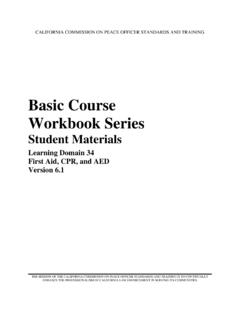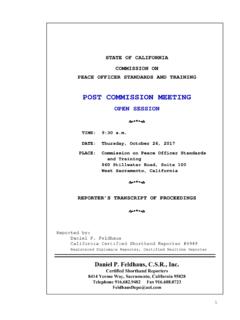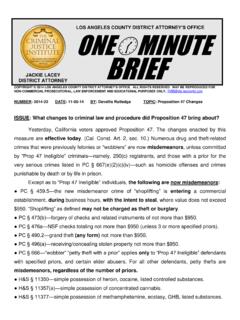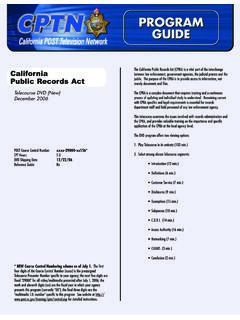Transcription of Basic Course Workbook Series - California
1 California COMMISSION ON PEACE OFFICER STANDARDS AND TRAINING Basic Course Workbook Series Student Materials Learning Domain 36 Information Systems Version THE MISSION OF THE California COMMISSION ON PEACE OFFICER STANDARDS AND TRAINING IS TO CONTINUALLY ENHANCE THE PROFESSIONALISM OF California LAW ENFORCEMENT IN SERVING ITS COMMUNITIES Basic Course Workbook Series Student Materials Learning Domain 36 Information Systems Version Copyright 2006 California Commission on Peace Officer Standards and Training (POST) All rights reserved. Published 1999 Revised July 2002 Revised January 2006 Correction July 2016 Correction March 2018 This publication may not be reproduced, in whole or in part, in any form or by any means electronic or mechanical or by any information storage and retrieval system now known or hereafter invented, without prior written permission of the California Commission on Peace Officer Standards and Training, with the following exception: California law enforcement or dispatch agencies in the POST program, POST-certified training presenters, and presenters and students of the California Basic Course instructional system are allowed to copy this publication for non-commercial use.
2 All other individuals, private businesses and corporations, public and private agencies and colleges, professional associations, and non-POST law enforcement agencies in-state or out-of-state may purchase copies of this publication, at cost, from POST as listed below: From POST s Web Site: Go to Ordering Student Workbooks POST COMMISSIONERS Joyce Dudley Vice Chair District Attorney Santa Barbara County Rick Braziel-Vice Chair Educator Humboldt State University Lai Lai Bui Sergeant Sacramento Police Department Thomas Chaplin Chief Walnut Creek Police Department Richard DeLaRosa Mayor City of Colton Robert Doyle Sheriff Marin County Laren Leichliter Deputy Sheriff San Bernardino County Geoff Long Public Member John McMahon Sheriff San Bernardino County Jethro Moore.
3 II Public Member James O Rourke Officer California Highway Patrol Batine Ramirez Sergeant Placer County Sheriff s Department Laurie Smith Sheriff Santa Clara County Walter Vasquez Chief La Mesa Police Department Stephen Lindley Representing Xavier Beccera Attorney General Ex-Officio Member Interim Director of Division of Law Enforcement THE ACADEMY TRAINING MISSION The primary mission of Basic training is to prepare students mentally, morally, and physically to advance into a field training program, assume the responsibilities, and execute the duties of a peace officer in society. FOREWORD The California Commission on Peace Officer Standards and Training sincerely appreciates the efforts of the many curriculum consultants, academy instructors, directors and coordinators who contributed to the development of this Workbook .
4 We must also thank the California law enforcement agency executives who allowed their personnel to participate in the development of these training materials. This student Workbook is part of the POST Basic Course Training System. The Workbook component of this system provides a self-study document for every learning domain in the Basic Course . Each Workbook is intended to be a supplement to, not a substitute for, classroom instruction. The objective of the system is to improve academy student learning and information retention and ultimately contribute to you becoming a peace officer committed to safety, and to the communities you will serve. The content of each Workbook is organized into sequenced learning modules to meet requirements as prescribed both by California law and the POST Training and Testing Specifications for the Basic Course .
5 It is our hope that the collective wisdom and experience of all who contributed to this Workbook will help you, the student, to successfully complete the Basic Course and to enjoy a safe and rewarding career as a peace officer. MANUEL ALVAREZ, Jr. Executive Director LD 36: Information Systems i LD 36: Information Systems Table of Contents Topic See Page Preface Introduction How to Use the Student Workbook iii iii iv Chapter 1: California Law Enforcement Telecommunications System (CLETS) Overview Introduction to the CLETS Department of Justice Requirements Unauthorized Access or Use of Information Criminal Offender Record Information (CORI) Chapter Synopsis Workbook Learning Activities 1-1 1-1 1-3 1-7 1-12 1-17 1-28 1-29 Chapter 2.
6 Department of Justice Information Systems and Databases Overview The Criminal Justice Information System (CJIS) Chapter Synopsis Workbook Learning Activities 2-1 2-1 2-3 2-47 2-48 Continued on next page Table of Contents, Continued ii LD 36: Information Systems Topic See Page Chapter 3: Department of Motor Vehicles Information System Overview Department of Motor Vehicles System/Databases Chapter Synopsis Workbook Learning Activities 3-1 3-1 3-3 3-12 3-13 Supplementary Material S-1 Glossary G-1 LD 36: Information Systems iii Preface Introduction Student workbooks The student workbooks are part of the POST Basic Course Instructional System. This system is designed to provide students with a self-study document to be used in preparation for classroom training.
7 Regular Basic Course training requirement Completion of the Regular Basic Course is required, prior to exercising peace officer powers, as recognized in the California Penal Code and where the POST-required standard is the POST Regular Basic Course . Student Workbook elements The following elements are included in each Workbook : chapter contents, including a synopsis of key points, supplementary material, and a glossary of terms used in this Workbook . iv LD 36: Information Systems How to Use the Student Workbook Introduction This Workbook provides an introduction to the training requirements for this Learning Domain. It is intended to be used in several ways: for initial learning prior to classroom attendance, for test preparation, and for remedial training.
8 Workbook format To use the Workbook most effectively, follow the steps listed below. Step Action 1 Begin by reading the: Preface and How to Use the Workbook , which provide an overview of how the Workbook fits into the POST Instructional System and how it should be used. 2 Refer to the Chapter Synopsis section at the end of each chapter to review the key points that support the chapter objectives. 3 Read the text. 4 Complete the Workbook Learning Activities at the end of each chapter. These activities reinforce the material taught in the chapter. 5 Refer to the Glossary section for a definition of important terms. The terms appear throughout the text and are bolded and underlined the first time they appear ( , term).
9 LD 36: Chapter 1 - California Law Enforcement Telecommunications System 1-1 (CLETS) Chapter 1 California Law Enforcement Telecommunications System (CLETS) Overview Learning need Peace officers must know the laws regulating access and use of law enforcement information systems to ensure privacy of individuals, and the integrity and security of the information. Learning objectives The chart below identifies the student learning objectives for this chapter. After completing study of this chapter, the student will be able to: Objective ID Recognize the requirements of the Department of Justice regarding the confirmation of information obtained from the CLETS network Recognize crimes involving unlawful access or use of a law enforcement computer system Recognize requirements for authorized release of Criminal Offender Record Information (CORI) based on right-to-know and need-to-know Continued on next page Overview, Continued 1-2 LD 36: Chapter 1 - California Law Enforcement Telecommunications System (CLETS) Learning objectives (continued) After completing study of this chapter, the student will be able to.
10 Objective ID Recognize crimes related to the unauthorized release, receipt, or use of CORI including: - Furnishing the information to an unauthorized person - Lawfully receiving the information and then furnishing it to an unauthorized person - Purchase, receipt, or possession of the information by an unauthorized person In this chapter This chapter focuses on crimes related the laws and regulations related to the use of law enforcement information systems. Refer to the chart below for specific topics. Topic See Page Introduction to the CLETS 1-3 Department of Justice Requirements 1-7 Unauthorized Access or Use of Information 1-12 Criminal Offender Record Information (CORI) 1-17 Chapter Synopsis 1-28 Workbook Learning Activities 1-29 LD 36: Chapter 1 - California Law Enforcement Telecommunications System 1-3 (CLETS) Introduction to the CLETS Introduction Access to accurate, timely, and complete information is essential to enhance officer safety and allow peace officers to carry out their day-to-day activities and duties.














